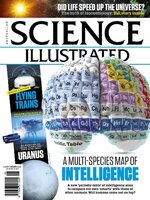Science Illustrated delivers natural science, break through discoveries and an understanding of the world for the entire family. Packed with stunning photography and in-depth editorial it’s a visually spectacular gateway to the world looking into the beginning of life to distant objects in the universe.
BACK to SCHOOL SPECiAL
Science Illustrated Australia
MEGAPIXEL // COMET TAIL
Boosting food production with turbocharged photosynthesis • Soy beans activate a defence against intense sunlight. A new study uses gene modification to turn off that defence more quickly, and the result is a remarkable 20% yield increase.
Our black swans may be vulnerable to avian flu • A study led by the University of Queensland has generated a first-ever genome of the black swan. It reveals that the species lacks some immune genes which help other wild waterfowl combat infectious diseases.
Vast ripples found on the edge of the Solar System • Several surprises have emerged from a study in which astronomers analysed data from three different spacecraft to examine the boundary between interstellar space and the huge gas bubble that envelopes our Solar System.
Rapid evolution saved Chernobyl’s frogs • Radiation is still simmering in the green zones around Reactor 4. One of the area’s smaller inhabitants has adapted to the hostile environment in an unusual way, according to a new study.
Is Queen Nefertiti waiting behind these walls? • Unidentified mummies and hidden hieroglyphs found in Tutankhamen’s tomb may indicate a long-awaited discovery.
What happens when I sneeze? • How does a sneeze happen, and is it dangerous to suppress one?
Can you understand ‘chimpanzee’? • Scientists have used an online test to discover that humans understand many gestures made by other great apes. You can try the quiz yourself.
Why are snow crystals hexagonal? • No two snowflakes are the same, they say, but why is their basic structure always flat and hexagonal?
Water molecules love hexagons • As we look ever more closely at snowflakes, the hexagonal shape is repeated over and over again, right down to the level of individual water molecules.
Why do we have nails?
Where in the Solar System does a year last the longest? • A year is defined as one trip around the Sun. Earth takes 365 days, but where is the Solar System’s longest year?
Do other planets have solar eclipses? • Do the other Solar System planets also experience total and partial solar eclipses like the ones we witness on Earth?
Why do people love royalty?
…we all lie regularly? • “We’re taught not to tell lies, and yet I often catch adults and parents lying – and myself too. Why do we do it?”
Is Earth today the hottest ever?
WHAT IS THIS? · Nanomedicine
Did modern man send Neanderthals extinct? • There are competing theories for the disappearance of Neanderthals, all of which might be partially true. So could our ancestors have infected them with diseases that killed them off?
LOST IN SPACE? WHO YOU GONNA CALL? SPACE RESCUE! • All space tourists so far have returned safely to Earth, but with space traffic increasing, an in-space emergency will occur sooner or later. The busier space gets, the more urgent the need for a rapid rescue service.
Rescue service to conquer space • Astronauts in trouble have little hope of help if stranded in space. Aerospace engineer Grant Cates proposes three key precautions required to improve safety in space.
Three fatal accidents changed aerospace • A total of 15 people have lost their lives in connection with a space mission. Space agencies have learned from the accidents and introduced particular safety improvements following these three fatal accidents.
How animals see the...

 Issue 111
Issue 111
 Issue 110
Issue 110
 Issue 109
Issue 109
 Issue 108
Issue 108
 Issue 107
Issue 107
 Issue 106
Issue 106
 Issue 105
Issue 105
 Issue 104
Issue 104
 Issue 103
Issue 103
 Issue 102
Issue 102
 Issue 101
Issue 101
 Issue 100
Issue 100
 Issue 99
Issue 99
 Issue 98
Issue 98
 Issue 97
Issue 97
 Issue 96
Issue 96
 Issue 95
Issue 95
 Issue 94
Issue 94
 Issue 93
Issue 93
 Issue 92
Issue 92
 Issue 91
Issue 91
 Issue 90
Issue 90
 Issue 89
Issue 89
 Issue 88
Issue 88
